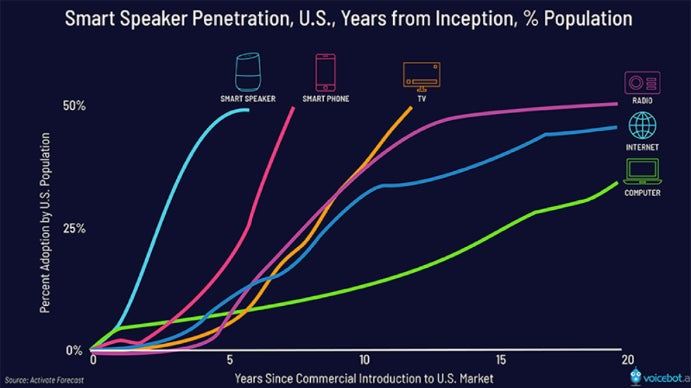Voice Goes Deep
Today’s tap, type, and swipe digital experience is rapidly transitioning to a voice-first experience that will let brands better reach and understand their customers, sell products, and build personal and long-lasting relationships. Bret Kinsella, editor and publisher of Voicebot.AI, shares his insights on the current and future state of voice and the implications for brands.

This article is part of our March 2019 series about emerging technology. Click here for more.
Today’s tap, type, and swipe digital experience is rapidly transitioning to a voice-first experience that will let brands better reach and understand their customers, sell products, and build personal and long-lasting relationships.
“Voice engages a new sense,” said Bret Kinsella, editor and publisher of Voicebot.AI, which covers all aspects of voice tech. “Voice will enable direct conversations at scale like never before, which I expect will deepen relationships through more engaging conversations.

CMO.com: Why do you think voice is the fastest-adopted tech in history, even faster than mobile adoption?
Kinsella: Voice is the first and most primary way humans communicate. It’s native to us. Voice assistants are the first time where the technology has been built to adapt to our primary communication method. Anyone can talk to one of these devices and can get immediate results.
Smart speakers were a very important evolutionary step, enabling consumers to discover the utility of voice assistants. We’ve also seen that people who adopt smart speakers then begin to adopt and use voice assistants on their smartphones with more frequency because they learned more about the functionality and utility of voice and how frictionless this UX is relative to a screen-based UX.

Lastly, the introduction of ambient far-field voice recognition [sound recognition from a distance] has opened up a whole new set of use cases and innovations in places like your home, office, car, and public spaces.
CMO.com: When I heard your keynote at the 2019 Alexa Conference in January, you divided voice technology into two phases. Can you describe them?
Kinsella: The voice-first era began in 2014. Just a few years ago, there were fewer than 100 million devices with voice assistants worldwide. As of fall 2018, there were over 1 billion voice assistant devices worldwide. So Phase 1 of voice growth was about introducing the technology and getting reach, access, and adoption by making voice UI an option on devices, localizing for language, getting global distribution, and broadening the feature set.
Phase 2 will be about habituation and specialization that move existing use cases to voice, decoupling voice from devices, creating purpose-built voice devices, customizing voice devices, and adding feature depth.
CMO.com: Generally speaking, consumers expect any brand experience to be relevant and personalized. How can brands deliver a high-quality CX through voice?
Kinsella: You first need to understand who the user is—and there are different levels of knowing who they are—so you can customize their usage. For example, is it a new user or a returning user? They would each have different welcome flows. If you can create account linkage, you can more deeply understand the user. The major platforms allow you to do this.
CMO.com: Building an audience on voice means a lot more data for brands to manage. What should CMOs and CIOs be thinking about?
Kinsella: Like any new channel, new structured data will be generated, which needs to be introduced into your data management and portfolio planning practices. There will be a new set of contexts in terms of how, where, when, and why users are interacting with you via voice, such as at home or in the car. This should not be a heavy lift for most organizations.
There will also be new unstructured data generated from the spoken dialogue users have with the device. This data can be used to improve UX by identifying errors to learn where users have problems to then improve the support application. This new data will also help you learn much more about your users because you’ll see what people are asking for, the problems they need solved, and their aspirations. You may see things you never considered. Every voice user becomes a focus group of one for the brand because you’ll be able to gather objective and subjective data like sentiment.
CMO.com: And that’s just the tip of the iceberg. What else must CMOs and CIOs get a handle on?
Kinsella: Voice is now a consumer expectation, so your brand needs to have a presence. It is imperative for brands to learn how to optimize for voice to stay relevant and engaged with their consumers. If consumers ask for you and you are not there, a Wikipedia message may come up with content that you don’t control and may not want consumers to hear. Or their query might get flipped over to one of your competitors, and then they will own that interaction and transaction.
Also, you simply can’t repurpose other digital content that you have. You need to create new voice-ready sonic branding and content. There is an opportunity for brands to create unique sound marks that will build the persona of the brand, which could become a memorable trust mark. This is a significantly new activity for all of us. The vocal and non-vocal sounds of your brand are a new design language and identity.
What’s also different is that now you have opportunities for unbounded interactions where consumers can ask for anything and your brand now has the opportunity to better address consumers’ needs. You need to anticipate what they could ask for in a conversation.
Also important to understand is that search algorithms used by voice assistants are different than what has been used on the web. There is a bias in voice assistants today to funnel consumers toward tailored voice experiences because they will likely be a better experience for consumers that ask the query by voice. This is the first time that the search algorithms have changed significantly in the last 15 years. It is a new way that search queries will be arbitrated.
CMO.com: What industries do you think are best-suited for voice technology and in what ways?
Kinsella: Any vertical that has direct consumer interaction is a candidate for voice. We now have over 1.5 billion access points, and voice is a digital channel that is natural and low-friction. That’s why we see a lot of CPG, media, insurance, and banking brands adopting voice so quickly.
However, the best way to think about voice is not by vertical but rather by use case, like answering questions, providing simple services or transactions, and delivering media. If voice is done correctly, brands can move out of having a utility status to having a richer experience status.
Right now there are more B2C opportunities because voice is such a good way for brands to have a dialogue with users. This is a fundamental shift in how we think about interacting with users where they can opt in and out in a conversation with a brand. And these interactions are more meaningful to them because they can get right to the point, use their natural method of communication in their own words. Voice is a true pull mechanism.
CMO.com: Thinking more long term, how do you think voice will evolve in the next five years?
Kinsella: There will be continued distribution growth to get voice assistants to be where people are. Five years from now, microphones will be everywhere. Voice will also be fully integrated with all other media and screens. This means we will have expanded use across surfaces and devices, we will have a rise in specialized niche voice assistants, and we’re going to see a lot more applications. Consumers will assume that your brand has a voice presence and will have an expectation that you will be able to help them. Consumers will also expect an exceptional voice UX.

https://www.slideshare.net/adobe/state-of-voice-assistants-2019